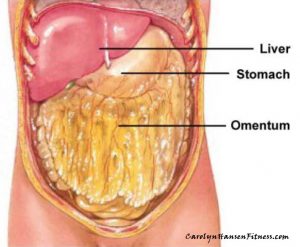
For many years, medical doctors have been aware that people who are “apple-shaped” …(those who tend to store their fat around their waist) – have a higher risk for chronic medical conditions than those whose bodies conform to more of a pear-shape because they store fat in their lower body – on their hips, buttocks and thighs.
Even though they knew this to be true, the reasons why were a mystery.
Until now. With the advent of medical imaging devices that can peer directly inside our bodies, providing detailed images of every section of the tissues that make us who we are, things are changing. Scientists are now able to get a better, clearer look at the nature of “belly fat” …thereby opening insights into its behavior regarding our hormone balance and its effect on overall health.
Most people are aware of the bodies vital organs such as the heart, liver, kidneys and spleen. However, they have never heard of the omentum, because it is not one of the vital organs and life threatening conditions have not been strongly related to the functioning of this organ in the past.
The omentum is more of a slow-motion regulator of bodily processes and has not gotten much limelight. In fact, hearing that they even have a physical organ in their belly responsible for storing fat is more than a little surprising to most.
 Measuring approximately 14 inches in length and 10 inches in width, the omentum can be thought of as your “belly fat bag.” This layer of fatty tissue hangs down like an apron inside the abdomen, is positioned in front of the intestines and sits underneath the stomach muscles. The lower edge of this fatty mass goes down near the pelvis in the lower abdominal area. At its upper edge, it is attached to the transverse colon which is located just below the stomach.
Measuring approximately 14 inches in length and 10 inches in width, the omentum can be thought of as your “belly fat bag.” This layer of fatty tissue hangs down like an apron inside the abdomen, is positioned in front of the intestines and sits underneath the stomach muscles. The lower edge of this fatty mass goes down near the pelvis in the lower abdominal area. At its upper edge, it is attached to the transverse colon which is located just below the stomach.
Appearance wise, the omentum looks a great deal like panty hose with wide webbing. When you are lean, and your body has a healthy (high) ratio of muscle to fat, your omentum will be quite think and certainly in no way noticeable to you. However, as you become overweight, this organ grows larger as globules of fat fill up the spaces of the webbing.
This “lace apron” drapes over the stomach area and when it starts to clog with fat it becomes bunches up and clumped. This is when an excessively large omentum becomes a ticking time bomb, releasing dangerous inflammatory chemicals into the bloodstream. These chemicals in turn harm organs and tissues in the abdomen and open the door for disease to set in, an all too common occurrence in our modern day sedentary world.
Considered one of the main fat reservoirs in the body omentum varies greatly in size depending on the amount of fat accumulated within. When swollen with deposited fat, the omentum is responsible for the infamous “pot belly” shape we love poking fun at. It can be quite firm to the touch, not soft and marshmallowly like you’d probably expect it to be.
Modern science is revealing deeper secrets of the omentum, showing that it is actually dynamic tissue having many functions other than just the storage of fat.
It also protects and cushions and acts as structural integrity for our internal organs. It can be viewed as something of a safety net for the bits and pieces that make up the complex biology of the digestive system.
Unfortunately, many people have way more protective cushioning that is necessary or healthy for them.
Dire Consequences
The consequence of excess belly fat, whether you are male or female is the production of excess quantities of the female hormone estrogen. The is particularly bad news for men, as “manliness” will begin to subside as female hormones override the “manly” master hormone testosterone.
This higher than normal level of estrogen will change a male body from one that is firm and muscular to one that is flabby and soft. Depression and fatigue follow as well as problems in the bedroom.
Female don’t fare much better suffering with “discomforting” problems to massively intrusive conditions such as breast cancer. Increased belly fat is the result along with a merry-go-round of hormone imbalances attributed to estrogen overload.
If you have a protruding belly and it feels firm when you push it, and you have an apple-shaped body then it is likely that your omentum is storing way more fat than it should be.
The good news is, if you lose some fat weight, the omentum and the fat around your vital organs such as your heart and kidneys will be the first things to shrink. As you reduce these stores of fat, you will automatically reduce the total amount of inflammatory chemicals deposited into your body and this in turn leads to a reduction in levels of stress-inducing hormones that are causing your body to gain fat weight.
The key, not surprisingly, is lifestyle changes. It’s proper exercise and healthy nutrition that works and a willingness to accept that perhaps the time has come to finally get serious and treat your body with the respect it deserves.
Not only will reducing your all-over body fat percentage make a difference in the size of your omentum, but it will have positive health benefits overall. A healthy body is, after all, the one thing that has the unique ability to help you reach old age!
If we want to live a long healthy life, we must avoid chronic inflammation and avoid disease and the only way to do that is to honor our body with what it needs…consistent, proper exercise supported by healthy eating. There are no short cuts.
If you ready to tap into the power of your self-healing processes in order to MAXIMIZE your level of health…
“Activate The Self Healing Process Within You” can help you do just that.
It reveals powerful but “simple Lifestyle Strategies to help resist aging and maintain superior health.” Inside, you’ll learn the best natural techniques for preparing your body to defend itself against disease no matter how insidious the threat.





Leave A Comment